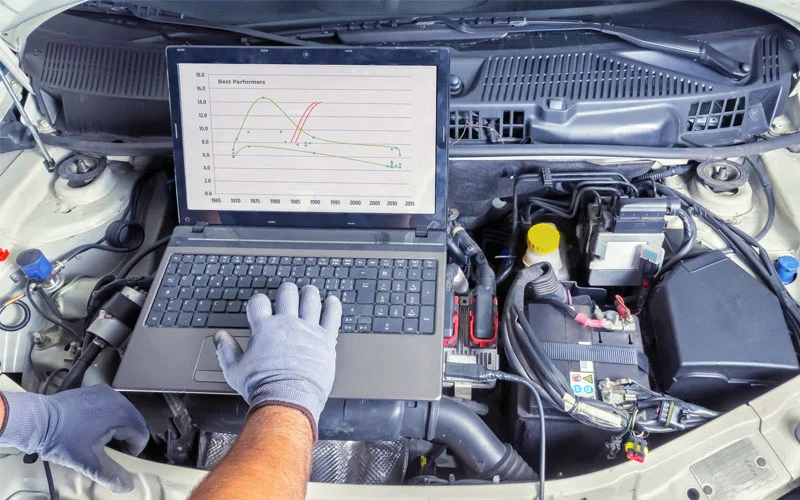In an age where artificial intelligence (AI) is permeating almost every aspect of our lives, it’s not surprising that it’s also making its way under the hood of our cars. AI-powered diagnostics are revolutionizing car maintenance, making it more efficient, cost-effective, and precise. In this article, we’ll explore the impact of AI in the automotive industry, from predictive maintenance to streamlined service processes.
Predictive Maintenance: Keeping Ahead of the Curve
One of the most significant advantages of AI in car maintenance is its ability to predict issues before they become major problems. Traditional car maintenance schedules often rely on generic guidelines, like changing the oil every 3,000 miles. With AI, these schedules become tailored to your specific driving habits and conditions. The AI algorithms analyze data from your vehicle, such as engine performance, driving patterns, and weather conditions, to predict when your car actually needs an oil change service.
Efficiency in Service: Reducing Downtime
AI is not just about predicting maintenance needs but also about optimizing the service process itself. When you bring your car to a service center, AI can help technicians diagnose problems more quickly and accurately. By analyzing the data from your car’s onboard systems and comparing it to vast databases of known issues, AI can pinpoint the exact cause of a problem. This means less time spent diagnosing issues and more time fixing them, reducing the downtime for car owners.
Cost Savings: Avoiding Unnecessary Repairs
One of the biggest pain points for car owners is unexpected and costly repairs. AI can help mitigate these concerns by identifying issues before they become serious. For example, if your vehicle’s sensors detect a minor issue with your engine, AI can notify you and the service center, allowing you to address the problem before it turns into a major repair. This proactive approach not only saves you money but also keeps your vehicle in better condition, increasing its lifespan.
Customized Maintenance Plans: Tailored to Your Needs
AI doesn’t just optimize the timing of oil changes. It can also create customized maintenance plans based on your driving habits and the specific make and model of your car. For instance, if you own a hybrid vehicle, an AI system can create a maintenance plan that considers the unique needs of a hybrid engine. This tailoring ensures that your car receives the precise care it requires, enhancing its overall performance and longevity.
Real-Time Monitoring: Staying Connected
With AI-powered diagnostics, your car is no longer a passive machine that you only pay attention to when something goes wrong. AI allows for real-time monitoring of your vehicle’s health. You can access this information through a dedicated app on your smartphone or a web portal. If you’re due for an oil change service or if there’s a potential issue, you’ll be notified immediately. This level of connectivity and awareness keeps you in control and ensures your car’s reliability.
Environmental Impact: Reducing Waste
AI’s role in car maintenance isn’t just about efficiency and cost savings; it also has a positive impact on the environment. Traditional maintenance schedules often lead to unnecessary oil changes, generating waste and consuming more resources. AI, with its data-driven approach, reduces these inefficiencies, resulting in fewer oil changes and less waste. This not only benefits your wallet but also contributes to a more sustainable automotive industry.
The Human Touch: Combining AI with Expertise
AI can do wonders for car maintenance, but it’s not a complete replacement for human expertise. While AI can diagnose issues and predict maintenance needs, experienced technicians are still crucial for implementing the necessary repairs and servicing your vehicle. The combination of AI’s precision and human skill ensures the best possible care for your car.
The Future of Car Maintenance: AI-Driven and Customer-Centric
As AI continues to advance, the future of car maintenance looks promising. AI-powered diagnostics are shifting the industry towards a customer-centric model, where service is tailored to individual needs, and maintenance is proactive rather than reactive. This not only makes car ownership more convenient but also extends the life of vehicles, reducing the environmental impact of manufacturing and disposing of cars.
Conclusion:
AI-powered diagnostics are transforming car maintenance by making it smarter, more efficient, and cost-effective. From predictive maintenance to tailored service plans, AI is changing the way we care for our vehicles. It’s not just about an oil change service; it’s about a comprehensive shift towards a more connected, sustainable, and customer-centric automotive industry. Embracing AI in car maintenance is not just a trend; it’s a smart investment in the future of your vehicle and the planet. So, as you drive into the future, let AI drive your car’s maintenance needs with precision and care.

